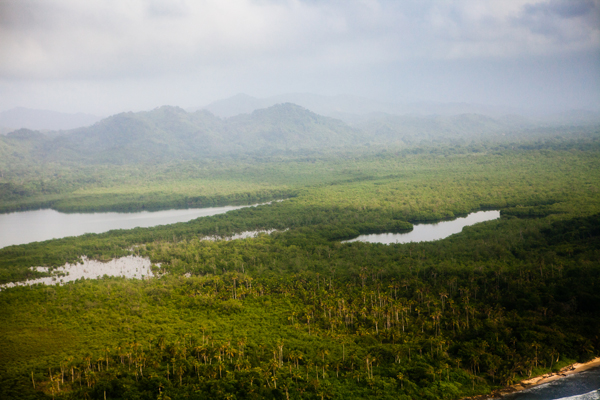Part I of this series: Life & Climate Change in Guna Yala
Part III of this series: Passing Down Traditions
The indigenous Guna of Panama are at the forefront of a new finding about forest conservation and climate change. A 2014 report by the World Resources Institute surveyed deforestation and emissions analyses from the most heavily forested countries around the world. Their conclusions were not surprising: It turns out that land held by local communities and indigenous peoples tends to be significantly less impacted by deforestation than land managed by governments or private entities.
Thanks in part to their exceptional sovereignty and land tenure, the Guna have preserved their primary forests for hundreds of years through their cooperative use of the land and their cultural and spiritual traditions rooted in conservation.
In this multimedia piece, we follow Andrés de León and the Yarsuisuit collective, a group of men who grow and harvest food sustainably in the Guna mainland forest. They also run a store on the island of Ustupu that helps support their families, serving as a model for the wider community.
Between the Forest and the Sea, Pt. 2: The Yarsuisuit Collective from roberto (bear) guerra on Vimeo.
OTHER PHOTOS BY ROBERTO (BEAR) GUERRA

A Kuna elder passes thatched-roof homes along the edge of Ustupu Island as he returns in his dugout canoe with buckets of landfill from his plot of land in the mainland forest. With parts of the island rapidly eroding due to flooding and rising sea levels, many families use landfill to keep the water at bay. Photo by Roberto (Bear) Guerra.

The Kuna’s mainland forest as seen from the air in July 2014. Photo by Roberto (Bear) Guerra.

Don Jesús Smith looks through old photos at the desk in his home on Ustupu Island. Don Jesús is the grandson of the Kuna revolutionary leader, Nele Kantule, and an outspoken advocate and teacher who is trying to ensure that young Kuna boys and girls learn about their culture. Photo credit: Bear Guerra.
 A photo shows Don Jesús Smith’s grandfather, Nele Kantule (left). Kantule led the Kuna revolution against the Panamanian government in 1925, and won the Kuna’s exceptional sovereignty and land rights as an indigenous group. He also stressed the preservation of Kuna culture and language, notions that continue to inspire Don Jesús in his efforts today. Photo credit: Bear Guerra.
A photo shows Don Jesús Smith’s grandfather, Nele Kantule (left). Kantule led the Kuna revolution against the Panamanian government in 1925, and won the Kuna’s exceptional sovereignty and land rights as an indigenous group. He also stressed the preservation of Kuna culture and language, notions that continue to inspire Don Jesús in his efforts today. Photo credit: Bear Guerra.
}}
Related articles
Between the forest and the sea: life and climate change in Guna Yala – Part I

(10/27/2014) The island-dwelling Guna people of Panama are one of the most sovereign indigenous communities in the world, but now severe weather and sea level rise are causing regular flooding on many of the islands, and will likely force the Guna to have to abandon their island homes for the mainland. This multimedia piece offers an introduction to everyday life and customs in Guna Yala and touches upon the uncertain future the Guna are now facing thanks to the impacts of climate change.
Balu Wala, or the Kuna ‘good life’: how one indigenous tribe is passing on its traditions (photos)

(10/03/2014) Jesús Smith is sitting at his old wooden desk facing the entrance to his house. He’s hunched over, shirtless, and wearing his chunky reading glasses while writing copious notes by hand — a favorite pastime. When he sees the profile of one of his students, Julio, walking past his doorway, he yells, ‘Hey! I’ll see you in class tomorrow!’
REDD+ versus indigenous people? Why a tribe in Panama rejected pay for their carbon-rich forests

(09/04/2014) There isn’t a word or phrase in the Kuna language for “carbon trading,” and much less for something as complex as REDD+. Standing for Reducing Emissions from Deforestation and Degradation, REDD+ is the worldwide UN-backed climate change mitigation scheme that relies on carbon trading within forest landscapes to fund forest conservation programs. And yet, since 2008, the Kuna people have been hearing lots about it and referring to it often in their private conversations.